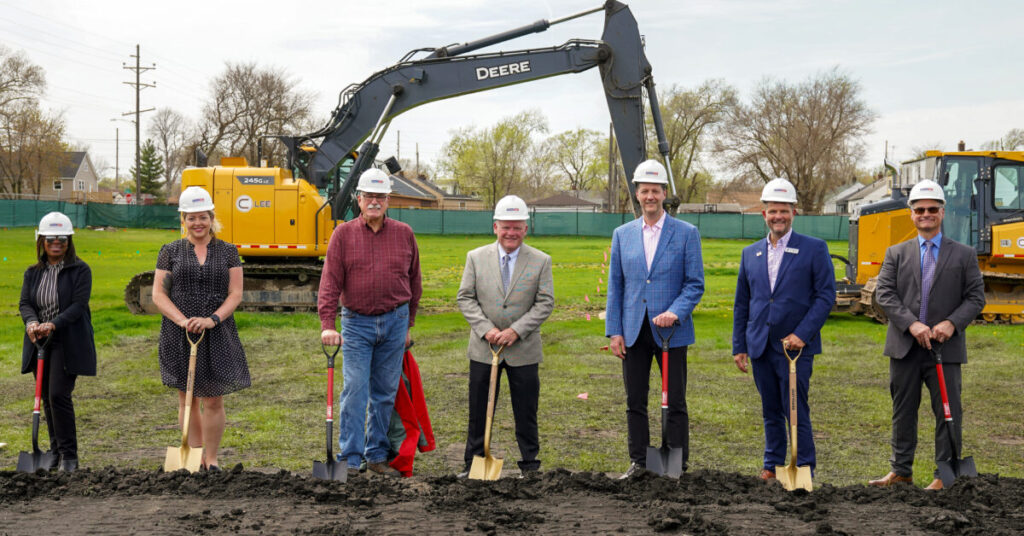Banking technologies add convenience, but some still prefer bricks and mortar.
by Jerry Davich
Today's banking customers have more options than ever regarding their finances, but also more checks and balances when it comes to daily decision-making. Should they choose old habits over new technologies? Convenience over complexities? Face-to-face interactions versus online interfacing? Pen and paper accounting versus mobile accessibility? “The future is here today,” says Bob Buhle, a senior partner at Centier Bank.
Buhle, who is 60 and whose father was a banker, clearly remembers most of the modern-day upgrades in the banking industry through the decades. This growing list includes automatic teller machines, or ATMs, debit cards, online checking and cell phone apps, to name a few of the more popular financial services and products. “But it still comes down to how you want to handle your banking through different delivery mechanisms,” says Buhle, who's been with Centier for 26 years.
In the “olden days,” customers had little choice but to visit a brick-and-mortar branch office to make deposits, withdraw money or conduct other transactions. And if you didn't get there on a Saturday before noon, you were stuck until Monday morning. These days are marked by evolving online bill paying, emerging iPhone and Android applications, reloadable prepaid cards and “Popmoney,” a person-to-person payment service offered by many financial institutions. Countless other options are already in the works. “Plus, there are simply more daily transactions made today than in years past,” says Buhle, whose company was recently nationally recognized as one of the top community five banks for social media usage.
At Centier, roughly 35 percent of its customers use online banking, about average in the industry, with only 15 percent using smart-phone mobile banking, which is still in development.

mobile banking has happened at a staggering pace.
Fifth Third Bank has seen an 11 percent spike in mobile banking over the last eight months, with a steady increase over the past three years. “In light of this constantly changing behavior of our clients, we continue to invest in our distribution network,” says Andrew Hayes, the bank's vice president of public relations. “We've spent a lot of time perfecting these elements, knowing that people who are mobile and on the go want products that are fast, simple and easy to work with.”
Because ATMs can accept cash and checks, Fifth Third is now working to supplement its brick-and-mortar locations with self-service kiosks and locations throughout its footprint. Each of these locations will have a telephone allowing customers to call 24/7 to resolve problems, order checks or make appointments to meet with a local banker, among other services. “Clients today want banking to be convenient,” Hayes says. “If they want a quick and easy transaction, they can visit an ATM. If they want to sit with someone and get questions answered or issues resolved, they can visit a branch.”
Mobile and Internet banking products allow customers to easily transfer funds, pay bills, manage credit needs and access transaction history on all of their accounts. These products have been on the market for the last eight to 10 years, though the technology behind it has been rapidly improving in more recent years. “We are hearing from older clients more and more who want to get trained on how to manage their money online,” Hayes notes. “One reason we are seeing this uptick of interest is concern over being scammed by unscrupulous people.” With online banking, clients can instantly see their transaction history and can then thwart any problem or get answers for any issue immediately.

“It's an interesting time to be in banking because of the constantly changing behavior of our customers of all ages,” Hayes says. Age certainly plays a role in using or relying on more modern banking techniques, industry leaders say. For instance, there is a “learning curve” with most older clients, prompting banks to educate these customers on how to navigate online banking, manage it and set up regular payments. “Some customers are leery of change and new technology, but when we explain that online and mobile banking will improve their banking experience, saving them time and money, they are open to trying it,” says Ben Bochnowski, executive vice president and chief operating officer for Peoples Bank.
“We also emphasize that conducting banking online is more secure, since you are eliminating the chance of something getting ‘lost in the mail,'” Bochnowski says. “Once customers try these services, they usually end up telling us they wish they would have tried them years ago.” Though online banking became available in the late 1990s, and Peoples Bank introduced mobile banking in 2011, traditional banking is still the most popular option for most Americans. In the banking industry, it's called “expanding the physical footprint.”
“There are some things you just can't do with a mobile phone and, as a community bank, we are there for our customers when they need us,” Bochnowski says. With that said, mobile banking is growing every month and it's expected to surpass online banking in the near future, says Jill Hasiak, vice president and product manager for Citizens Financial Bank. “As check volume continues to decline, paperless transactions are becoming the norm,” Hasiak says. “A client will usually select an electronic payment method based on whether or not they want to control when the bill is paid.”
Banking is still a service business and its clients frequently want to talk with someone, Northwest Indiana bankers agree. “The personal touch is still important, which exemplifies our personal banking philosophy,” Hasiak says. Fifth Third takes a hybrid philosophy to these ongoing changes by offering a more consultative approach. “For example, when we meet with a client we can also bring a range of other bank employees with varying expertise–mortgage, investments, retirement planning, estates and trusts, business, military/veteran products and so on,” Hayes says. “The bank branch will continue to be important for us and our clients, as this is where our ‘One Bank' term is experienced.”
Daniel Haisley, electronic business development manager at 1st Source Bank, says numerous technologically advanced processes are taking place in the background of his company. Each one is making an impact on routine transactions that clients have been making for years in banking centers. One example: Checks were previously sent by mail to the Federal Reserve for clearing, which often took several days to complete. Today, they're imaged and sent electronically, cutting down the transaction to a one-day process. “To the client, this reduces float time and much of the uncertainty that surrounded writing and receiving checks,” Haisley says.
Financial institutions across the board are routinely upgrading their consumer and business online banking with customizable financial centers. This allows customers to access any number of services with a click of the mouse, from viewing account balances and transaction histories to initiating transfers and bill payments. However, even tech-minded banking officials such as Haisley understand that electronic banking isn't for everyone.
“Many of our clients have worked with their same bankers for years, if not decades. And many more continue to step through doors for the first time to begin to establish those relationships,” he says. “Clients still want to know that if there is a problem, they can always look their banker in the eye and shake hands as the problem is resolved. Our mission is to help our clients build wealth, achieve security and realize their dreams–regardless of whether they prefer to step into a banking center or would rather log on from a mobile device.”
“From our standpoint, there's really no selling involved. We're happy to serve clients how they want to be served,” says Haisley, echoing other bank officials across the region. Does that mean they're going to walk into a branch office each time to make a deposit? “Not a chance,” Haisley replies. Consumers are driving the industry towards a “convenience through self-service” model for the transactional business, such as depositing checks, making withdrawals and even applying for loans or new accounts. Banks must account for this digital-friendly shift by shaping banking centers to meet the demand.
This is being done by catering to smart phone users, utilizing iPhone and Android applications, and even offering directions to the nearest ATMs and branches based on a client's GPS location.
“The rapid consumer adoption for mobile banking has been staggering and it's a real statement of clients' desire to be able to bank ‘how' they want and ‘when' they want,” Haisley says. “The adoption of smart phones crosses the tipping point.”
With technology always evolving, so does the industry to keep up with market demands, customer requests and new products, such as iPads, tablets, biometric security features or Google Glass, a wearable computer with a head-mounted optical display. “The trick is being able to introduce new technologies to clients while still maintaining the world-class, personalized service that sets us apart from the competition,” says Haisley of 1st Source Bank.
The most popular and applicable high-tech service is the ability to make a “mobile deposit,” allowing customers to take a photo of a check and submit it to a bank.
“Younger customers think nothing of taking a photo of a check while walking down the street and then having it deposited online via a mobile application,” Hayes says. In many ways, this “man versus machine” dilemma in banking reflects more universal themes in our ever-evolving society. Perks versus privacy. Technology versus dependency. Actual conversations versus virtual conveniences.
Through it all, timeless aspects remain a constant: Trust, credibility and comfort levels.
“Technology may continue to evolve, but the value in straight talk and sound advice still resonates as clients navigate the challenges of their financial lives,” Haisley says.
Buhle from Centier Bank agrees: “At the end of the work day, the nature of our business remains the same.”


